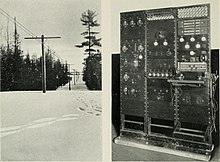This article needs additional citations for verification. (October 2015) |

The Beverage antenna or "wave antenna" is a long-wire receiving antenna mainly used in the low frequency and medium frequency radio bands, invented by Harold H. Beverage in 1921.[1] It is used by amateur radio operators, shortwave listeners, longwave radio DXers and for military applications.
A Beverage antenna consists of a horizontal wire from one-half to several wavelengths long (tens to hundreds of meters; yards at HF to several kilometres; miles for longwave) suspended above the ground, with the feedline to the receiver attached to one end, and the other end of the wire terminated through a resistor to ground.[2][3] The antenna has a unidirectional radiation pattern with the main lobe of the pattern at a shallow angle into the sky off the resistor-terminated end, making it ideal for reception of long distance skywave (skip) transmissions from stations over the horizon which reflect off the ionosphere. However the antenna must be built so the wire points in the direction of the transmitter(s) to be received.
The advantages of the Beverage are excellent directivity, a wider bandwidth than resonant antennas, and a strong ability to receive distant and overseas transmitters. Its disadvantages are its physical size, requiring considerable land area, and inability to rotate to change the direction of reception. Installations often use multiple Beverage antennas to provide wide azimuth coverage.
- ^ Beverage, Harold H.; Rice, Chester W.; Kellogg, Edward W. (January 1923). "The Wave Antenna - A New Type of Highly Directive Antenna". Trans. AIEE. 42. AIEE: 215–266. doi:10.1109/T-AIEE.1923.5060870. ISSN 0096-3860. S2CID 51649877.
- ^ Laporte, Edmund A. (1952). Radio Antenna Engineering. New York: McGraw-Hill Book Co. pp. 55–59.
- ^ Carr, Joseph J. (January 1998). "The Beverage Antenna". Popular Electronics. 15 (1). Farmington, IL: Gernsback Publications: 40–46. Retrieved July 1, 2016., also archived here